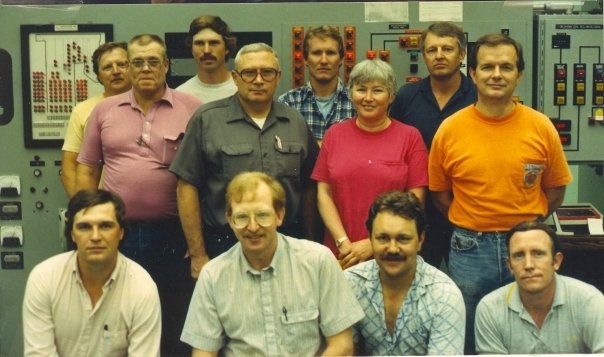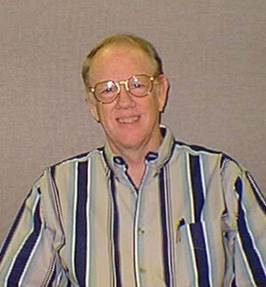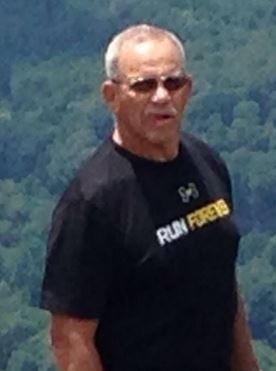I always loved playing with numbers, and thanks to the Birthday Phantom at the Coal-fired Power Plant in North Central Oklahoma, I knew everyone’s birthdays. so in 1996 I decided that I would chart them all on a graph. When I compiled them all, I found that the Power Plant was in for one heck of a train wreck. The entire basis that enabled the plant the size of a small city to run with a total of 121 employees was going to start crumbling within the next 13 years.
The original chart I made was in pencil. Here is a simple column chart of the employee ages from Excel:
Now study this chart for a minute…. The youngest person in the plant was 31. There was one. The oldest were four who were 56. If you take everyone from age 40 to 49, you have 70 employees, or 58% of the entire Power Plant population. So, in a 10 year period, the plant was going to lose a majority of their employees due to retirement. 35% were going to be retired within a 5 year period.
How did this happen? How is it that the youngest Power Plant Man was 31 years old and the age between the oldest and the youngest was only 26 years? This happened because of two situations.
The first one is that people rarely ever left the Power Plant, so new hires were rare. The second situation was that we had a downsizing in 1988 when the employees 55 and older were early retired. Then in 1994, we had another downsizing where everyone over 50 years old were early retired. So, we kept lopping off the older employees, without a need to hire anyone new.
There were three entry level jobs when I first hired on as a full time employee. I went through all of them. Summer Help, Janitor and Laborer. None of these jobs existed at the plant anymore. This had given new employees an introduction into Power Plant Life. It also gave the foremen an opportunity to pick those employees that had the natural “Power Plant Man” quality that was needed to work in this particular environment.
I brought my chart to the team and showed them how a train wreck was just down the road. Someone at Corporate Headquarters must have figured this out, so a couple of things were done to try and combat this situation. I’m sure the same problem must have existed at all of the power plants.
The first thing that was done was that the retirement policy was changed. Instead of having to wait until you were 60 to retire with full benefits, you could retire with full benefits when your age and your years of service added up to 80 or more. A couple of years after that policy went into effect, we calculated that Jim Arnold had 100 points when you added his age and his years of service.
As a side note:
When we added up Gene Day’s years of Service and his age it added up to 80. That’s because, even though he was 80 years old, no one could remember whether he ever did any service…. That’s why I didn’t include him in the chart above.
Sure. Gene had been hanging around at the Power Plants since they discovered electricity, but it never occurred to him to retire. He just walked around with his orange stapler (an Oklahoma State University fan). Anyway… I digress… Somehow, whenever I talk about being old, Gene Day always seems to pop up in my mind. I can see him waving his finger at me now (In case you’re wondering… read this post: “Power Plant Humor and Joking With Gene Day“, or “Psychological Profile of a Power Plant Control Room Operator“).
Back to the story:
The idea was that we should have people begin to leave the plant now instead of all waiting until they were the regular retirement age, so they could be replaced with younger souls. There was only one catch and the reason why a Power Plant this size could be run with only 121 employees…. well… it had grown to 122 by this time since Brent Kautzman had been hired in the Instrument and Controls department. He was 31 years old when he was hired. I remember his birthday since it was the same date as my parent’s anniversary.
The reason that the Power Plant could operate with so few employees was because the majority of the employees at the plant had many years of experience. The majority of the employees had over 20 years or more with the company. In fact, I had another chart that I had made at the time that showed how many years of experience we would lose each year that we had a large number of people retiring. In just one year we would have lost over 220 years of experience if something hadn’t been done soon.
The company decided to hire young inexperienced employees fresh out of vo-tech and begin training them to work at a power plant. They opened a new position at each of the plants to lead the training efforts. Someone that had some computer skills and could work with employees to help teach them in the ways of Power Plant Maintenance. A training program to head off an impending train wreck.
I won’t go into too much detail about how this worked but it consisted of building a training room where new hires would take computer courses then would work part time in the plant learning how things worked. Then they would take tests and if they passed them, they could move forward with the next part of their training. All they needed were people willing to give it a try with the understanding that if they didn’t pass their tests, they would lose their jobs by a certain time period.
Training Supervisor…. I think that was the name of the job opening that came out in October, 1997. I was ready for this one. I had a Masters in Religious Education from Loyola University in New Orleans, with an emphasis on Adult Education. I was the computer whiz at the plant. I could even write the entire training software from scratch with the help and knowledge of the Power Plant Men and Women.
The only problem with this job was that it was understood that at first the new training supervisor was going to have to be spending a lot of time going between the different plants with the training supervisors at each of the plants. I had just started going back to school at Oklahoma State University to work toward a Computer Science degree. If I had to travel a lot right away, my studies were going to have to be put on hold.
Even though I was looking forward to earning a Computer Science degree in the next four years, I thought that the Training Supervisor job would be a dream job for me, so I applied for it. My education could wait. I interviewed for it with Bill Green, the plant manager, who was the reporting manager for the job.
I explained to him that 50% of the work that I did when studying for my Masters in Religious Education (MRE) was learning techniques on how to teach adults. I had already shown my ability to do this using the computer when I taught the Switchman Training (see the post: “Power Plant Men Learn to Cope with ‘Boring’“). I had also taught almost the entire plant how to use Windows when it first came out.
I had created my own little Windows Manual that stepped people through opening up Microsoft Applications and how to maneuver around.
The Windows Icon was actually the Window Wingding character used for the Flying Windows Screensaver. I just added the colors to it.
Most of the people at the plant thought that I was a shoe-in for this job. I was custom designed for it. When the job was given to someone else, I was a little disappointed, but I was also relieved. This meant that I could go on with my work toward my degree. The job was given to Stanley Robbins. Stanley was a coal yard operator, and a very nice person.
One thing I had learned a long time ago with Scott Hubbard was that when someone is given a job that you really want, it isn’t the person who receives the job that should upset you. They were chosen by someone else. Through no fault of their own. This was a terrific opportunity for Stanley.
So, the day that Stanley began his new job, Bill Green was seen showing him around the plant, since he had spent most of his 18 year career up the hill at the coal yard. Stanley and Bill entered the electric shop and Bill asked where we kept the Electric Shop copy of the electrical blueprints. I showed him the cabinets where they were kept. Then they left.
About an hour later, Bill and Stanley returned to the shop and Bill came up to me and said that he had talked to Jerry McCurry in the training department in Oklahoma City (that is Corporate Headquarters), and he was looking for an audio book by Tom Peters, but Jerry said that I had checked it out. He wanted Stanley to read it. I told him that I had returned that audio book a couple of months ago, and now had a different audio book checked out at the time.
I took Bill and Stanley into the Electric Shop office and showed them a copy of a Tom Peters audio book that was my own personal copy “In Search of Excellence”, and gave it to Stanley and told him he was free to borrow it, as well as any of the other “motivational” business books I had, including a textbook on Organizational Behavior that I kept on the top of the filing cabinet to read during lunch when we couldn’t think of a fitting lunch time topic. I had another Tom Peters book on the bookshelf Stanley was free to read, “Thriving on Chaos”:
And a book left over from our “Quality Process” days that I had rushed out to buy the day I first heard about it from our Quality instructor:
Bill Green, our Plant Manager, who had never spent much time in the electric shop quickly learned a lot about me in those few minutes that he never knew. What he learned was that I was an avid student of just about anything I could learn. I had read every book in the Electric Company library and was now going through their list of Audio Books. I showed him the library catalog and explained to Stanley how to check out books. — Everything was still done through Intra-Company mail in 1997.
Even though I was intent on being as helpful as I could to Stanley (and I think Stanley would back me up on that. I always supported Stanley any way I could), at the same time I wanted to impress upon Bill Green that if he was really serious about making the Training Supervisor job a real success, he didn’t really pick the most qualified candidate.
With that said, I think Stanley became a great Training Supervisor. He was forever grateful for the opportunity for this position. He stated that to me over and over. I was glad for Stanley.
I was also relieved for myself, because my dream of becoming a “real” programmer was still a possibility. I continued with my school and was able to graduate in 2001. That is another story for a later time.
Six months after the training team had been chosen, and the trainers had settled into their positions, we heard that the company had purchased a specialized “Training Package” for about $400,000. With additional cost for each module that was added. Ray Eberle can tell me the price for each module, but it ran somewhere in the neighborhood of $40,000 for each one.
The training modules included one for each type of equipment in the plant. So, for instance, there was a module for a large vertical pump, and there was one for a large horizontal pump, and one for a small one, etc. Ray knew the prices because he was evaluating the course material for them to see if they were correct.
Ray came up to me one day and said he was embarrassed for the company who was creating the modules, because between a set of modules, they were nothing more than copying and pasting the same incorrect material in each one of them. The set of modules he was reviewing added up to $120,000, and they were all wrong.
I had looked at the application that we had bought and I could easily see that I could have written a much better program with the help of people like Ray and the other Power Plant Men to give me information. We were going to be spending over $750,000 for a computer training program that we could have created ourselves and then the company could have marketed it to other electric companies who were looking for a training program.
After I received my Computer Science degree I spent years working for Dell creating computer applications that performed any sort of feat that was required.
The train wreck finally hit the plant a few years ago, as a mass exodus of retirees left the plant. I wasn’t there to see it, so I don’t know if the plant ended up with a larger group of employees or not. I know that Stanley has retired, but I still picture him at the plant training new hires to become Power Plant Men.









You did a great job of doing the demograhics of your team mates. You did succession planning and highlighted to corporate.👍😀
LikeLiked by 1 person